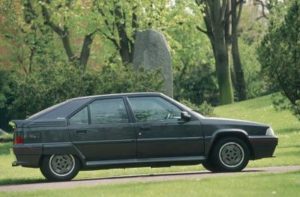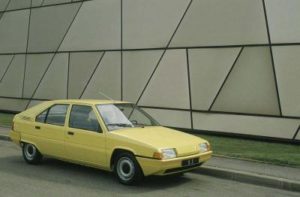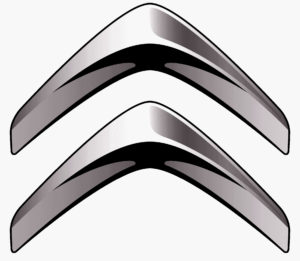
The ultimate 80’s family car – 1982 to 1993
Widely regarded as the car which saved Citroën from bankruptcy and credited for being the UK’s best-selling diesel car for a number of years, the BX model designed by Bertone as a replacement for the popular GS and GSA was the first venture of the recently formed ‘PSA’ group, thus sharing most of its main mechanicals with its Peugeot siblings.

Originally launched in France in September 1982 and in the UK the following year, the new car was available with a 1360cc or 1580cc petrol units in hatchback form only, with 14E, 14RE,16RS and plush 16TRS trim levels. The press of the day had mixed reactions; opinion being divided on the ‘quirky’ PRN dashboard, complete with drum speedometer, digital strip tachometer and satellite controls pods. It was too different from the Sierra and Cavalier rivals for most. However sales were brisk and the model became quite popular, thanks to its low running costs and fuel economy, which was aided by the use of weight-saving plastic panels for bonnet, tailgate and bumpers, it was also very competitively priced, had high equipment levels and of course, superb ride comfort compared to its steel sprung competitors.

A year after its UK launch the first diesel powered examples became available, initially with the 1905cc 65bhp XUD unit as fitted to the Talbot Horizon and Peugeot 305. Badged as the 19RD and 19DTR, they went on to rewrite the diesel rule book and became a huge success with private and fleet markets alike. That same year the first ‘sporting’ BX was unveiled as the 19GT model, with its 1905cc 105bhp, XU petrol engine, rear spoiler, front fog lamps and CX turbo style analogue dials but retained the rest of the satellite controls. This model was only in production for a little over 12 months so is very rare nowadays, as indeed are all Mk1s. Based on the 19GT Model mechanically and the 16TRS aesthetically, there was a special edition called the Digit with its main centrepiece being the fully digital dashboard. Aesthetically it is a toned down version of the 19GT and does not have bumper rubbing strips and front fog lights. The Digit is now an incredibly rare car nowadays, with very few being sold in the UK.
Citroën, already well-known for their capacious estate models, continued the tradition with the BX in 1985. Three models, the 16RS, 19TRS, (in essence a BXGT estate) and 19RD diesel models were launched. These proved to be good sellers but sadly have now all but disappeared – probably down to being well used as ‘workhorses’ combined with the fragility of some of the materials used in the earlier cars.
In late 1986 Citroën gave theBX range its biggest revision (to become known as the Mk2) which despite loosing some of its individuality, made it far more popular with more conservative buyers. Gone was the ‘ever so Citroën’ PRN dashboard, replaced by normal analogue dials, stalk controls for lights and wipers, revised switch gear, new chunkier bumpers, flared wheel arches (allowing for wider wheels to be fitted for the impending ‘hot’ versions) and larger front indicators as well as changes to interior trim fabrics. The now proven 1.9 diesel cars soon had a revised cylinder head which gave a useful power increase from 65 to 72 bhp and a 1769cc 60bhp diesel was also made available to the budget conscious fleet market.

The introduction of a GTi model shortly afterwards, with its fuel injected version of the 1.9 XU petrol engine, large rear spoiler and sports seats received rave reviews from the motoring press thanks to its exceptional performance of 125mph and sub 9 seconds 0-60 time. Today it is still capable of showing modern rivals a thing or two! For those needing more space, an estate version with similar running gear was available known as the 19TRI in 1988 and the 1360cc petrol engines gained the new ‘TU’ unit instead of the old gearbox-in-sump ‘suitcase’ engine known for its whining idler gear and vocal camshafts which developed with age and miles.
A year after the face-lifted models hit the showrooms Citroën launched the two models for which the BX range will always be remembered; the 90bhp 1769cc turbo diesel in RD turbo and DTR turbo models, and the fire-breathing twin cam 160bhp 1905cc GTi 16v. This model with its 135mph and ferocious acceleration was – and still is – a real driver’s car. The turbo diesels were a great success, particularly in estate form, combining petrol levels of performance with the economy and durability of a diesel and it is this model which retains significant popularity even now, over 15 years after production ended.
In 1989 another slight revision known as the Mk 2 ‘Phase 2’ models brought new ‘smoked’ rear lamps and wheel trims on hatchback models and two tone bumpers on the upmarket example. The trim derivatives were renamed with the ‘R’ designation being replaced by TG and TR by TZ. The GTi was upgraded to Motronic fuel injection from the earlier Jetronic. The GTi 16v, having dropped its GTi moniker in 1988 further distinguishing it from its 8v sibling, was now fitted with bespoke deep front and rear fibreglass bumpers, rear spoiler and two tone alloy wheels. Also at that time a 4wd version of the GTi hatch and a 1.9 carburettor fed petrol estate became available, these sold in small numbers and sadly very few survive in no small part due to the fact that the 4wd system wasn’t up to the job and would often break, leaving the cars totally immobile. The only notable change from then onwards was the fitment of catalytic converters (previously available as an option) and single point injection replacing carburettors in 1992 in response to new emission laws.
The BX continued to sell well in to the early 1990s, with the addition of a few special edition models, trim improvements and keen pricing strategy from Citroën. The hatchback model was discontinued in 1993 to be replaced by the larger – and heavier – Xantia, with the final few BX estate models rolling off the (Heuliez) production line in 1994. In total, over 2,500,000 examples were sold worldwide making it one of the best-selling Citroëns of all time. A staggering 62 different variants were available in the UK in its 11 year lifespan.
As with any car made in the 1980/90s there are surprisingly few examples left; many of the later cars, being fleet-owned, would have covered high mileages in their early years, so finding a decent one can be hard work. Most of the survivors seem to be diesels although the occasional low mileage petrol BX (very often with an automatic gearbox) does crop up, usually representing excellent value for money.
With any hydraulic Citroën watch out for those LHM leaks. Worn rear arm bearings are common with high miles as are failed head-gaskets – both on petrol and diesel models, rust has sent many a BX to the scrap yard so watch for holes in boot floors and inner wings, crumbling sills and detached door hinges, the interior trim is quite fragile (the lower specification models being particularly vulnerable to wear) but reasonably easily sourced. The mechanicals are still easy to find and relatively simple to work on, and parts are easy to obtain through the club and parts suppliers.


